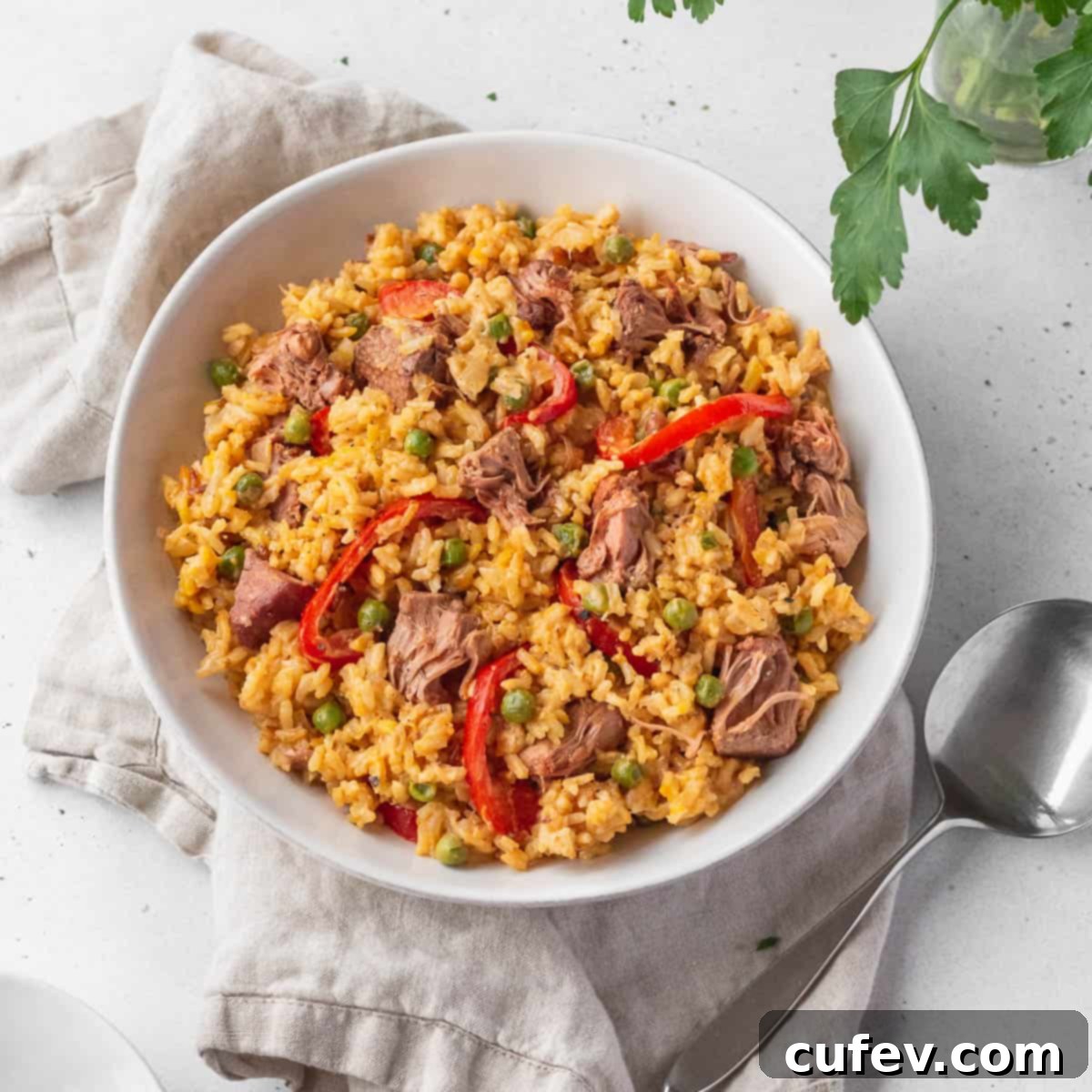Vegan Arroz Valenciana: Creamy, Flavorful Filipino Comfort Food (Easy One-Pot Recipe!)
Experience the rich, vibrant flavors of the Philippines with this incredible Vegan Arroz Valenciana! This hearty Filipino rice dish features aromatic jasmine and sticky rice cooked to perfection in creamy coconut milk, infused with savory tomato paste and a hint of luxurious saffron. Our plant-based rendition cleverly uses seasoned jackfruit confit, delivering a satisfying texture and deep flavor profile that rivals traditional chicken and chorizo versions, making it an utterly decadent and flavorful meal.
This beloved recipe was first published on March 1, 2020, and has since been perfected and updated with fresh photos and enhanced information on December 3, 2022, to bring you the best possible vegan experience.
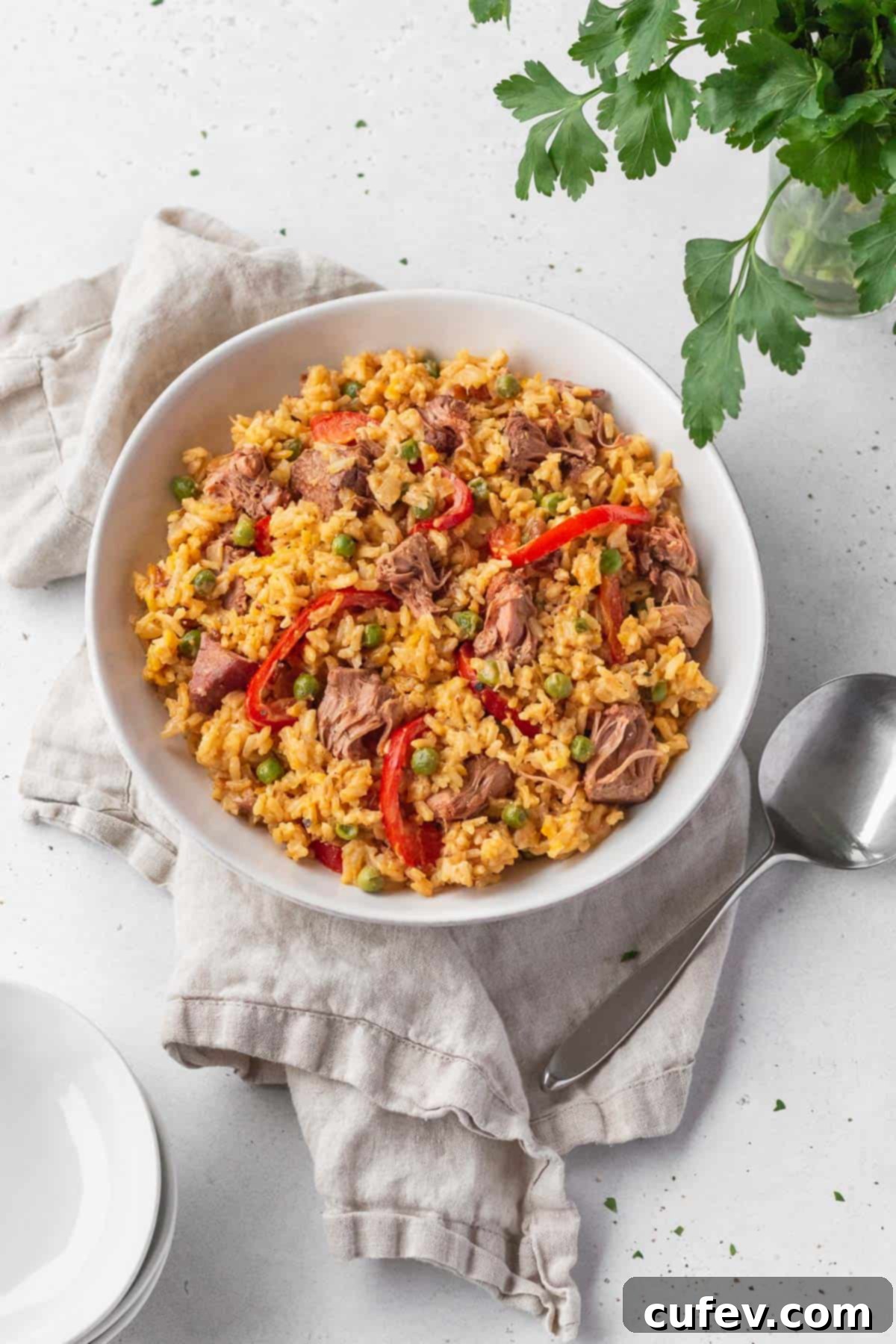
Table of contents
- What is Arroz Valenciana?
- Why You’ll Love This Vegan Arroz Valenciana Recipe
- Ingredients & Smart Substitutions
- Step-by-Step Guide to Cooking Arroz Valenciana
- Recipe Pro-Tips for the Perfect Arroz Valenciana
- Creative Recipe Variations
- Serving Suggestions
- How to Make Arroz Valenciana Ahead of Time
- Storage and Freezing Directions
- Storing Leftovers in the Fridge
- Storing Leftovers in the Freezer
- Frequently Asked Questions
- Essential Tools Needed to Make This Recipe
- Other Delectable Vegan Main Dishes
What is Arroz Valenciana?
Arroz Valenciana, also widely known as Arroz a la Valenciana, is a cherished Filipino rice dish frequently gracing holiday tables and special family gatherings. Its name and character clearly reflect the profound influence of Spanish colonization on Filipino cuisine, bearing a striking resemblance to the Spanish classic, paella, yet boasting its own unique Filipino twist. While paella often features specific seafood and cooking techniques, Arroz Valenciana adapts these influences with locally available ingredients and culinary traditions.
Traditionally, Arroz Valenciana is characterized by its core ingredients: a blend of rice, succulent chicken pieces, savory chorizo de Bilbao, vibrant green peas, rich coconut milk, and an array of aromatic spices. The result is a dish that’s incredibly rich, deeply savory, and infused with an intoxicating fragrance. Some regional and family variations might also incorporate hearty boiled eggs, and a colorful medley of fresh vegetables such as bell peppers, ripe tomatoes, and tender carrots, enhancing both its visual appeal and nutritional value.
My first encounter with this delightful dish was back in 2006, when a generous Filipino family friend shared her homemade Arroz Valenciana with us in a Tupperware container. Her particular rendition, less heavily spiced than some, also included sweet corn and plump shrimp, alongside the classic boiled eggs. It was an instant connection for me—a deeply comforting, coconut-infused meal that evoked a profound sense of “home” even though I had never tasted it before. This vegan version aims to capture that same heartwarming, rich experience, ensuring everyone can enjoy its comforting embrace.
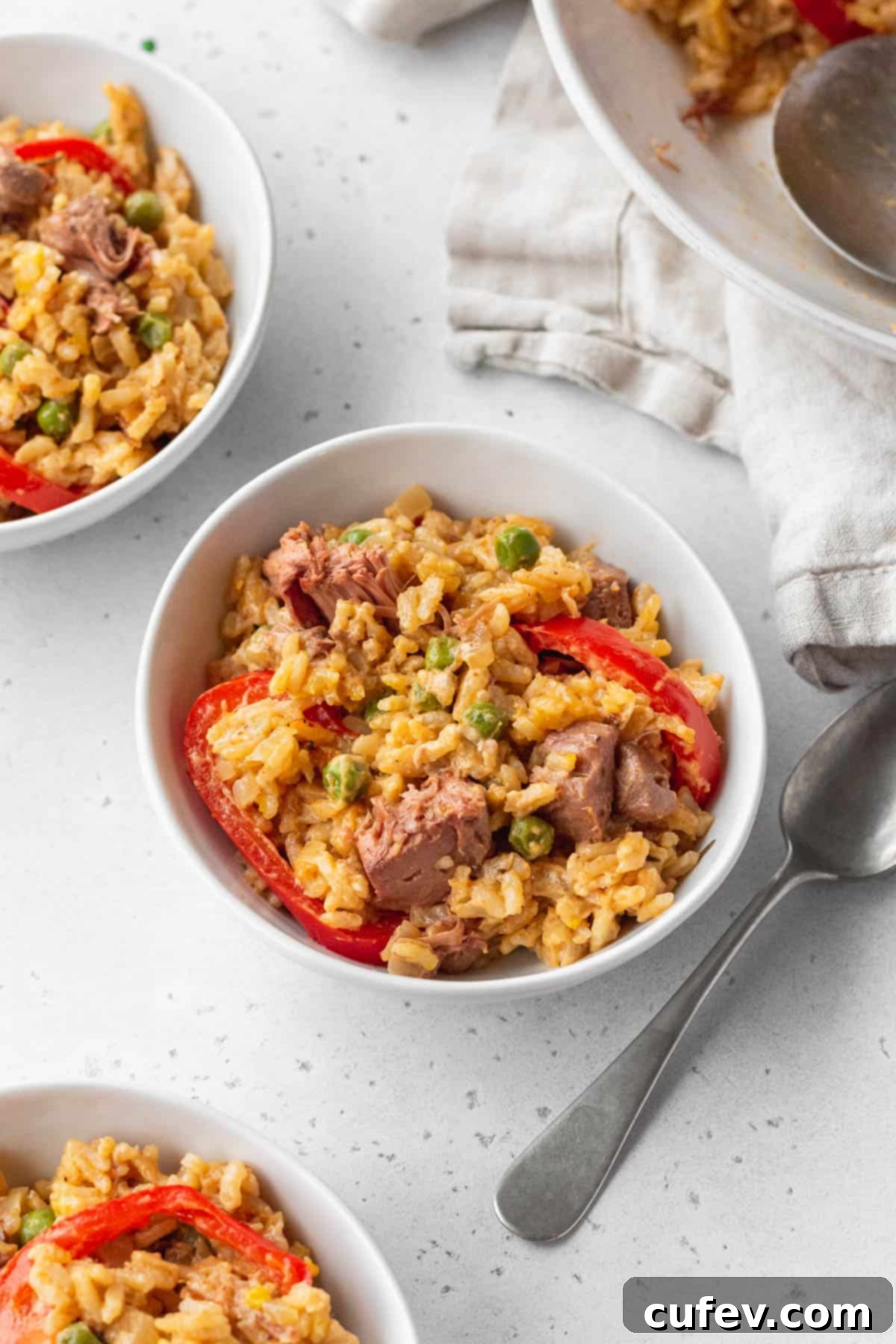
Why You’ll Love This Vegan Arroz Valenciana Recipe
Are you on the hunt for a meal that offers warmth, heartiness, and an explosion of flavor? Then this Vegan Arroz Valenciana recipe is precisely what you need! While it’s often a star during the festive holiday season, its delightful taste and straightforward preparation mean you’ll want to enjoy this incredible Filipino rice dish any day of the week.
Beyond its utterly scrumptious taste, this plant-based Arroz Valenciana offers numerous advantages:
- Creamy & Dreamy Texture: The secret to its luxurious mouthfeel lies in full-fat coconut milk. It ensures the rice is incredibly creamy and rich without ever becoming mushy. Each spoonful offers a smooth, comforting texture that’s simply irresistible.
- Intensely Aromatic: A tiny pinch of saffron is all it takes to elevate this dish with its distinctive, alluring aroma and beautiful golden hue. While saffron can be a premium spice, the small quantity needed here makes it a worthwhile indulgence for the incredible depth of flavor it imparts.
- A True One-Pot Wonder: Imagine creating such an impressive, flavorful meal all in a single pot! This vegan Arroz Valenciana is not only convenient for cleanup but also visually stunning. Its vibrant colors and inviting aroma make it a showstopper that truly deserves to be the centerpiece of your dinner table, perfect for impressing guests or simply treating yourself.
- Wholesome Plant-Based Goodness: This recipe offers a nutritious twist on a classic, making it suitable for vegan diets without compromising on flavor or satisfaction. Jackfruit provides a fantastic texture, while a generous array of vegetables adds essential nutrients.
- Rich & Savory Flavor Profile: The combination of tomato paste, smoked paprika, and cayenne pepper works in harmony to replicate and even enhance the traditional savory notes often derived from chorizo, offering a complex and satisfying taste experience.
- Customizable & Versatile: Easily adapt this recipe to your preferences by adding more vegetables, adjusting the spice level, or experimenting with different plant-based proteins. It’s a forgiving dish that welcomes creativity!
Prepare to fall in love with this vegan rendition of Arroz Valenciana—it’s comfort food redefined, offering a delightful culinary journey with every bite!

Ingredients & Smart Substitutions
To recreate this magnificent Filipino rice dish, you’ll need a carefully selected array of ingredients that balance traditional flavors with plant-based ingenuity. Here’s a breakdown of what you’ll need and potential substitutions:
- Jasmine Rice: This fragrant long-grain rice is a cornerstone of this dish, providing a delicate aroma and fluffy texture. While any regular long-grain rice can be used, jasmine rice elevates the overall experience with its distinctive perfume.
- Sticky Rice: Also known as sweet rice, glutinous rice, or “malangkit” in Filipino, sticky rice is crucial for achieving the characteristic slightly chewy texture and subtle sweetness of Arroz Valenciana. In a pinch, short-grain rice like sushi rice can work, but for the authentic texture and taste, sticky rice is highly recommended.
- Jackfruit Confit: Our star plant-based protein! I highly recommend Nature’s Charm young green jackfruit confit, which is pre-seasoned and tender. Its fibrous texture makes it an excellent meat substitute. If using another brand or plain young green jackfruit, ensure you thoroughly drain and shred it, then season it well with salt, pepper, and your favorite spices before frying to develop maximum flavor and crispy edges. Other meat substitutes like seitan, firm tofu (pressed and crumbled), or even hearty mushrooms can work, but adjust cooking times and seasoning accordingly.
- Olive Oil: Used for sautéing the aromatics. Extra virgin olive oil offers a rich flavor, but light olive oil, coconut oil, or any neutral cooking oil (like canola or grapeseed oil) can be used.
- Onion: A foundational aromatic. Both yellow or white onions work perfectly, providing a sweet and pungent base for the dish.
- Bell Pepper: Adds color, sweetness, and a fresh crunch. I used red bell pepper for its vibrant hue, but feel free to use yellow, orange, or a combination of different colored peppers to make your dish pop.
- Frozen Peas: A classic addition that brings a burst of sweetness and tender texture. No need to defrost them; they can go straight from the freezer into the pot, cooking quickly as the rice simmers.
- Garlic: Essential for a robust flavor base. Freshly minced garlic is always best, but good quality pre-minced garlic from a jar is a convenient alternative.
- Salt & Black Pepper: Basic seasonings to enhance all the flavors. Always taste and adjust as needed, as the saltiness of your vegetable stock can vary.
- Saffron: The touch of luxury! Just a tiny pinch of these threads imparts a beautiful golden color and a uniquely earthy, slightly floral aroma that is characteristic of traditional Arroz Valenciana and paella. It’s worth the small investment for the depth it adds.
- Smoked Paprika & Cayenne Pepper: These spices are key to recreating the smoky, slightly spicy depth that chorizo de Bilbao typically provides in the non-vegan version. Smoked paprika adds warmth and color, while cayenne pepper offers a gentle kick; adjust the amount to your preferred spice level.
- Tomato Paste: A concentrated burst of umami and rich tomato flavor. Tomato paste contributes to the dish’s vibrant color and savory depth, compensating beautifully for the absence of meat.
- Vegetable Stock: Forms the liquid base for cooking the rice. Choose a good quality vegetable stock or broth that you enjoy the flavor of, as it significantly impacts the final taste of the dish.
- Coconut Milk: The creamy heart of this Filipino version. I used Chef’s Choice coconut milk, and it’s crucial to use full-fat canned coconut milk for the richest, creamiest result. Light coconut milk will yield a less indulgent outcome.
Step-by-Step Guide to Cooking Arroz Valenciana
Creating this delicious Vegan Arroz Valenciana is a rewarding culinary journey. Follow these detailed steps to achieve a perfect, flavorful rice dish:
- Prepare the Rice: Begin by thoroughly rinsing the jasmine rice and sticky rice together under cold running water. Continue rinsing until the water runs clear. This step removes excess starch, preventing the rice from becoming overly gummy. Once rinsed, drain the rice well and set it aside.
- Crisp the Jackfruit: Heat a large, heavy-bottom pot (a Dutch oven works wonderfully) over medium heat. Add the contents of one can of jackfruit confit, including the oil, and the drained jackfruit from the second can. Use your spoon to break the jackfruit into smaller, bite-sized chunks. Cook, stirring occasionally, for about 8-10 minutes, or until the jackfruit edges become beautifully golden and slightly crispy. This caramelization adds significant texture and flavor. Carefully remove the crisped jackfruit from the pot and transfer it to a plate; set aside for later.
- Sauté the Aromatics: Without washing the pot, wipe it clean with a paper towel to remove any small jackfruit bits that could burn. Return the pot to medium-low heat and add the olive oil. Once shimmering, add the finely chopped onions and minced garlic. Sauté for about 5-7 minutes, stirring frequently, until the onions are translucent and fragrant, and the garlic is lightly golden. Be careful not to burn the garlic, as this can make the dish bitter.
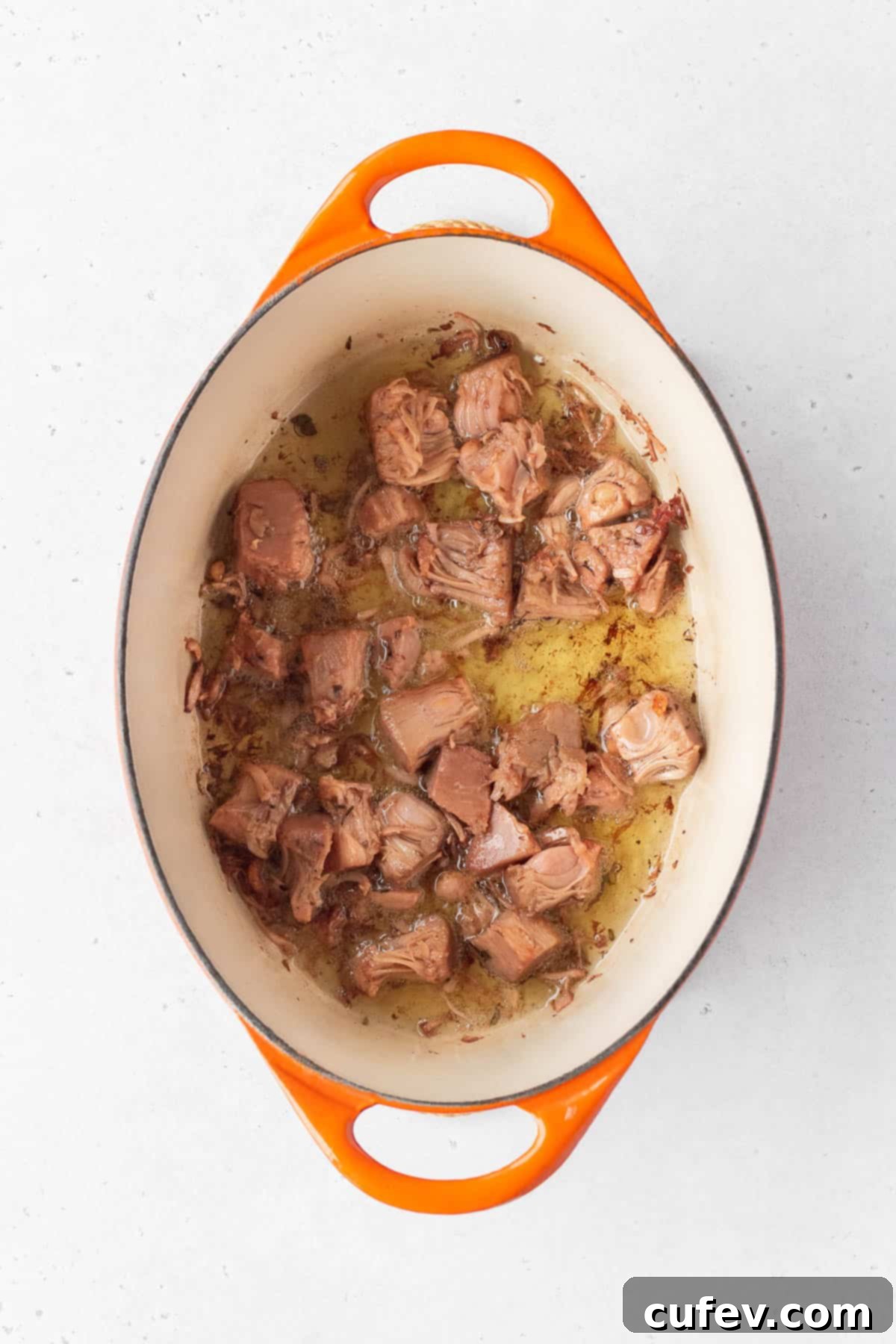
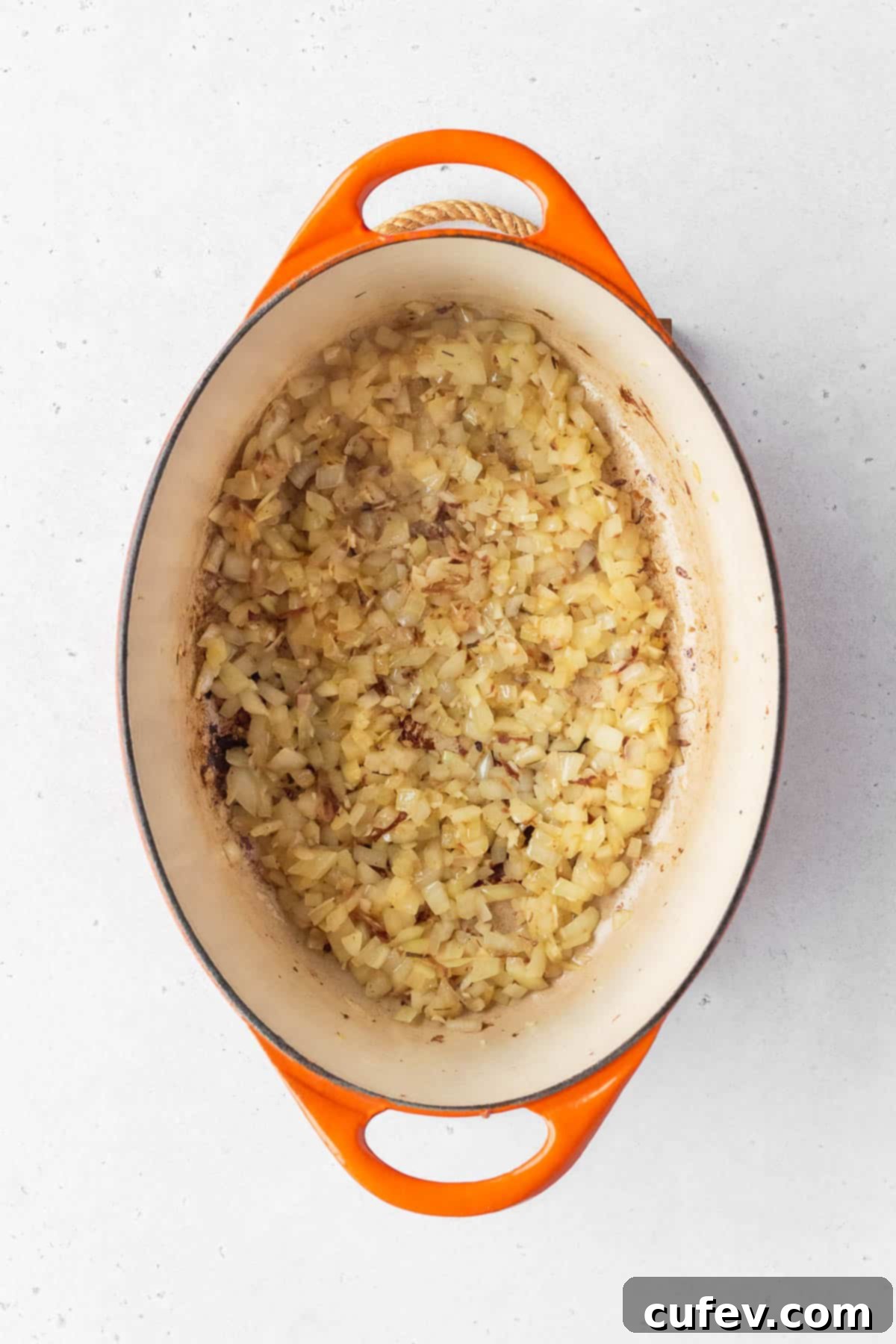
- Add Spices and Tomato Paste: To the sautéed onions and garlic, add the sea salt, black pepper, precious pinch of saffron, smoked paprika, and cayenne pepper. Stir continuously for about 1 minute until the spices become wonderfully fragrant and the tomato paste has fully coated the onions. This step helps to bloom the spices and deepen their flavor.
- Introduce Liquids and Rice: Pour in the vegetable stock and the rich coconut milk. Increase the heat to medium and bring the mixture to a gentle boil, stirring occasionally. Once boiling, add the rinsed rice to the pot and give it a good stir to ensure it’s evenly distributed in the liquid. As soon as the mixture returns to a boil, reduce the heat to low, cover the pot tightly with a lid, and let it simmer undisturbed for 5 minutes. This initial simmer allows the rice to start absorbing the flavorful liquid.

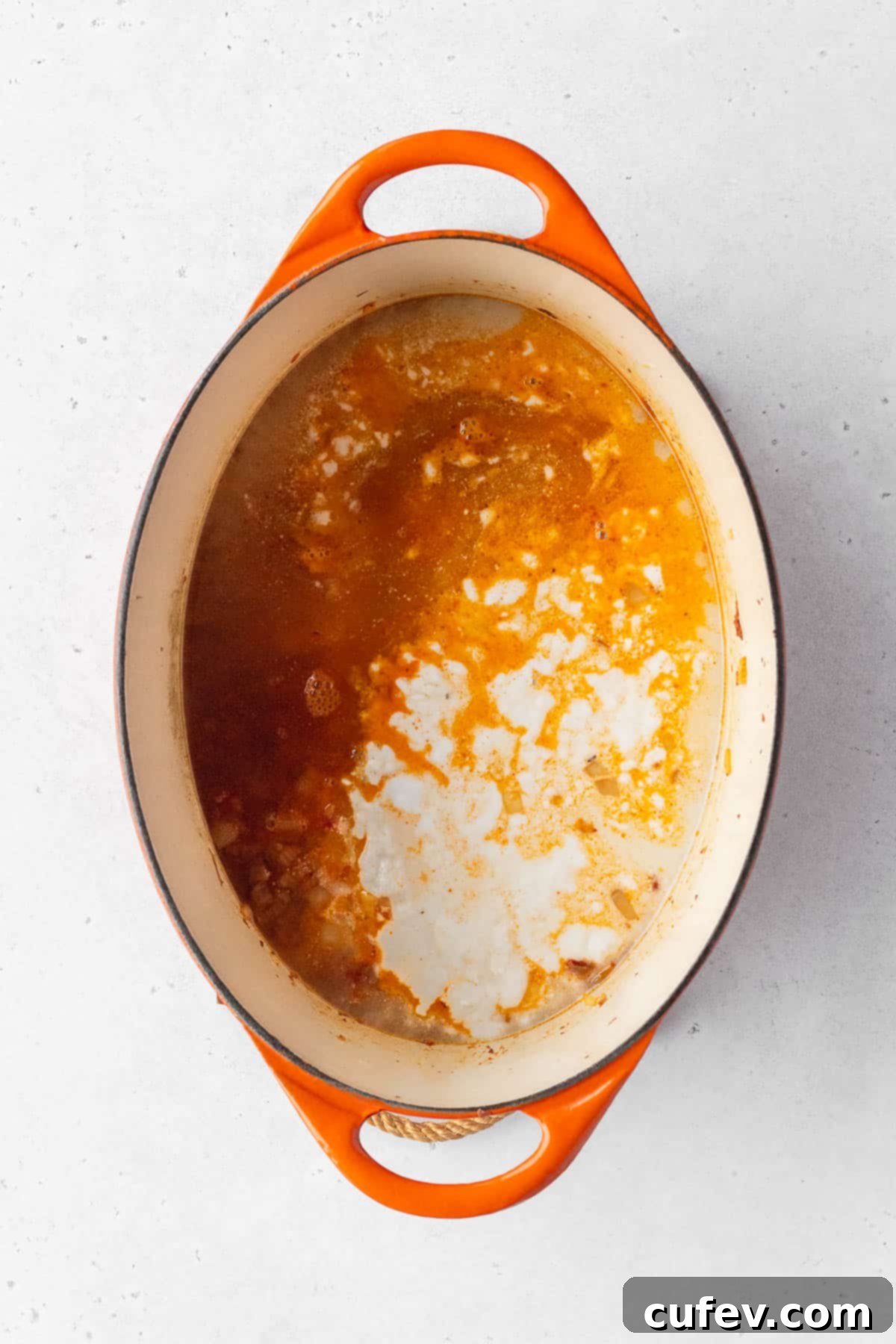
- Add Vegetables and Finish Cooking: After the initial 5-minute simmer, lift the lid (try to minimize steam escape) and add the frozen peas and sliced bell peppers. Stir them gently into the rice mixture. Replace the lid tightly and continue to simmer on low heat for another 15 minutes. It’s crucial not to lift the lid during this period, allowing the rice to steam properly and the vegetables to cook. After 15 minutes, turn off the heat but keep the lid on for an additional 5 minutes. This resting period allows the remaining steam to finish cooking the rice, ensuring every grain is perfectly tender and fluffy.
- Final Seasoning and Serving: Once rested, remove the lid and gently fluff the rice with a fork. Taste a spoonful for seasoning. If needed, add more salt or black pepper to your preference. Finally, incorporate the crisped jackfruit, stirring it through or arranging it artfully on top. Serve your magnificent Vegan Arroz Valenciana immediately while it’s still piping hot, ready to delight with its layers of flavor and satisfying texture.
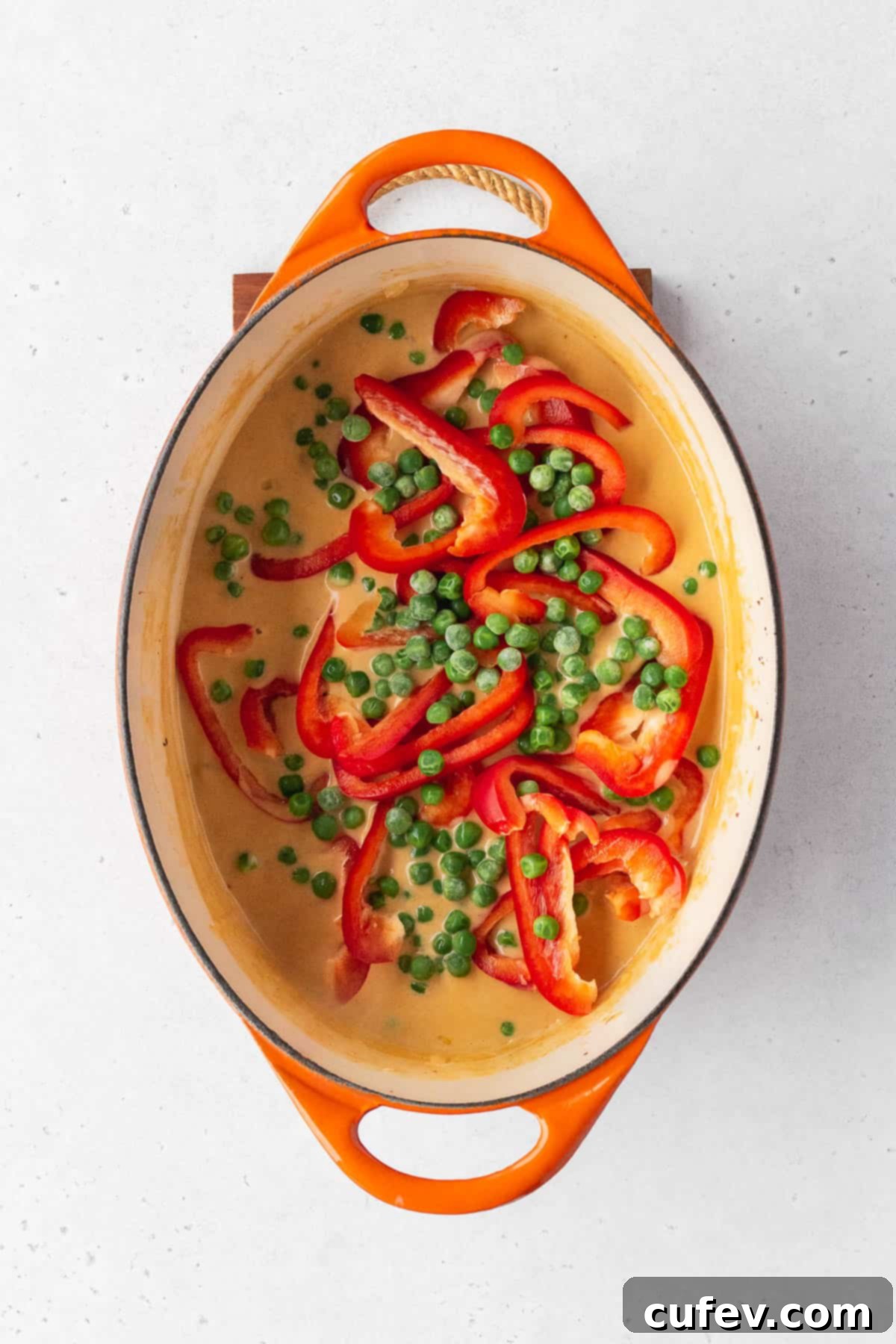
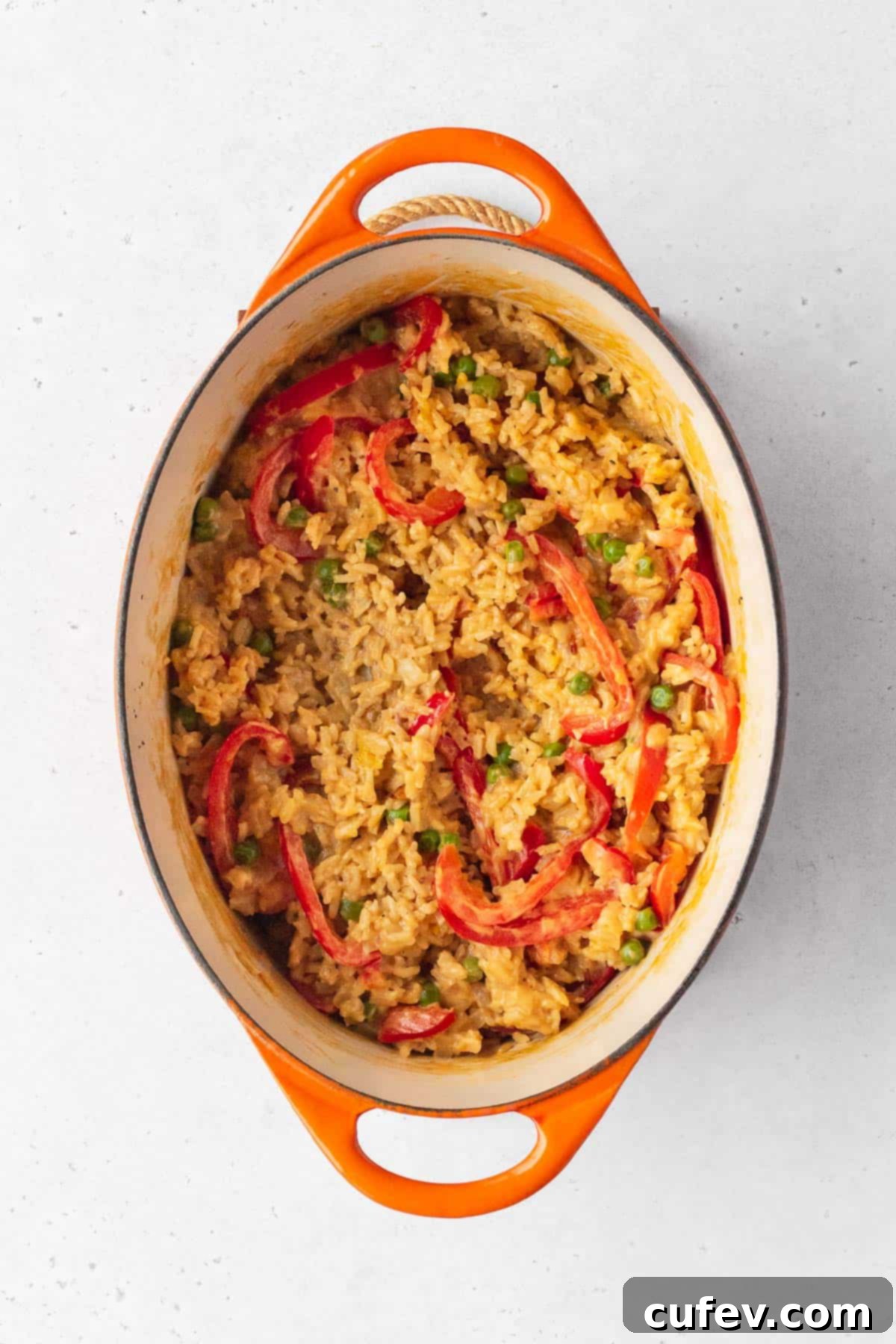
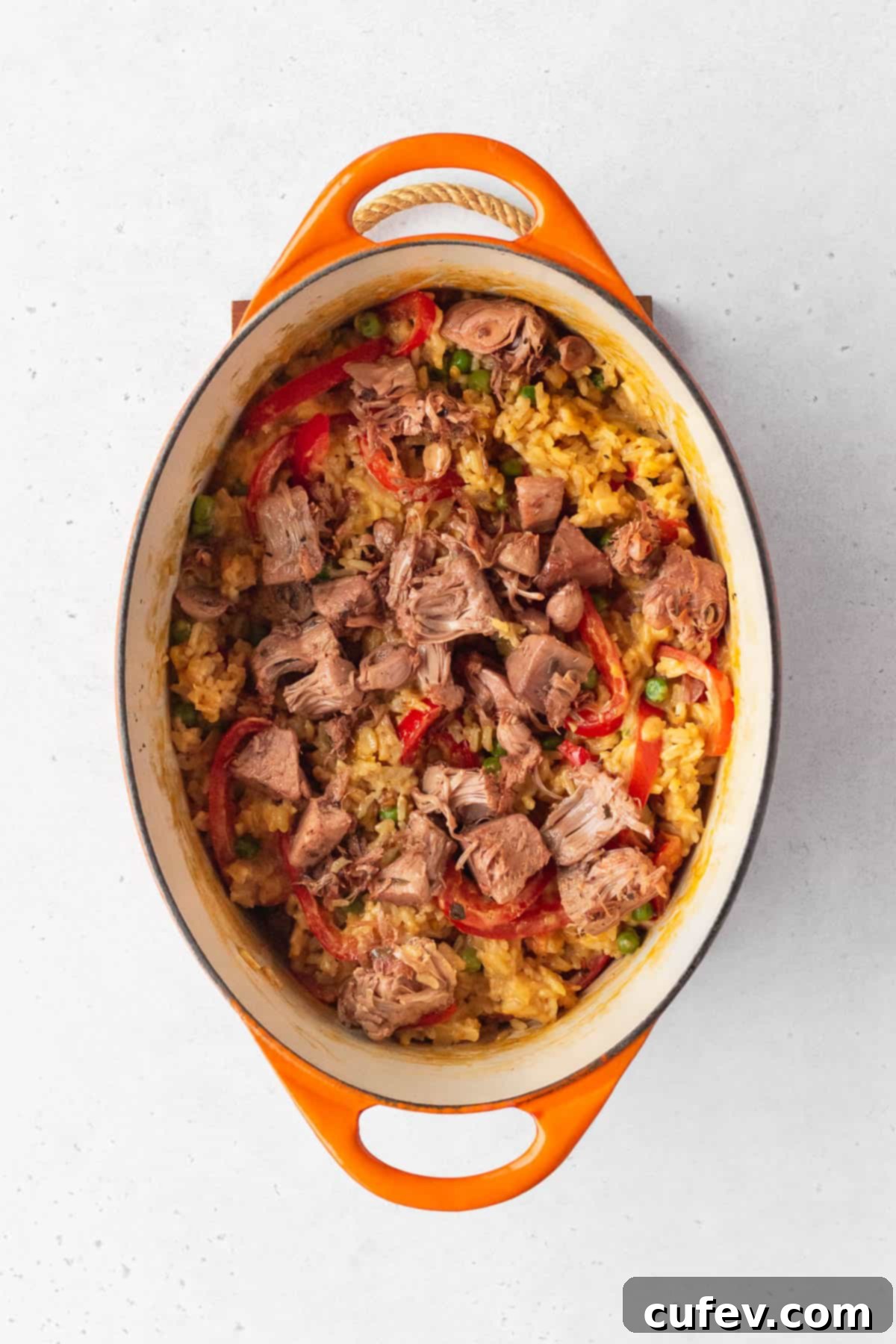
Recipe Pro-Tips for the Perfect Arroz Valenciana
Achieving a truly exceptional Vegan Arroz Valenciana is all about a few key techniques. Keep these professional tips in mind for the best results:
- Clean Your Pot Between Steps: After crisping up the jackfruit, take a moment to wipe the heavy-bottom pot clean. This crucial step removes any tiny bits of jackfruit or herbs that might have stuck to the bottom, preventing them from burning later and imparting an undesirable flavor to your rice. A clean pot ensures a clean, pure taste.
- Stir the Bottom, But Don’t Overmix: While cooking the rice, it’s important to stir occasionally, especially ensuring you scrape the bottom of the pan with your wooden spoon or spatula. This prevents the rice from sticking and burning. However, once the rice begins to simmer with the lid on, resist the urge to stir excessively. Over-stirring can break the rice grains and release too much starch, leading to a mushy texture rather than the desired fluffy yet creamy consistency.
- The Power of Resting: Don’t skip the final resting period after turning off the heat. Keeping the lid on and allowing the rice to sit for an additional 5 minutes is vital. This trapped steam gently finishes cooking the rice, ensuring all the grains are uniformly tender and have fully absorbed the rich flavors, resulting in a perfect texture.
- Rinse Your Rice Thoroughly: As mentioned in the instructions, rinsing your jasmine and sticky rice until the water runs clear is fundamental. This process washes away excess starch, which is particularly important for sticky rice, ensuring your Arroz Valenciana is creamy and cohesive, but not gluey.
- Taste and Adjust Seasoning: Always taste your Arroz Valenciana before serving. The flavor profile of vegetable stocks can vary significantly, so you may need to add an extra pinch of salt or a dash more black pepper to achieve your desired balance of flavors. Don’t be shy about making it perfect for your palate!
- Use a Heavy-Bottom Pot: A good quality heavy-bottom pot or Dutch oven distributes heat evenly, which is essential for cooking rice properly and preventing burning at the bottom. It also helps in achieving that coveted slightly crispy bottom layer (socarrat), though traditionally more associated with paella, it’s a welcome texture here.

Creative Recipe Variations
This vegan Filipino recipe is already incredibly delicious as written, but it’s also wonderfully versatile, allowing you to customize it to your personal preferences or what you have on hand. Here are some ideas to inspire your culinary creativity:
- Embrace More Veggies: The more vegetables, the merrier! You can easily add or substitute other vegetables to enhance the flavor and nutritional profile. Consider incorporating diced carrots, green beans, or even small potato cubes for a heartier texture. Sauté tougher vegetables like carrots or potatoes with the onions and garlic to ensure they cook through. Leafy greens like spinach or kale can be stirred in during the last few minutes of simmering until wilted.
- Spice It Up: If you love a bit of heat, increase the amount of cayenne pepper or add a dash of your favorite hot sauce or a few pinches of red chili flakes along with the other spices. For a deeper, spicier flavor, you could also add a diced jalapeño or serrano pepper when sautéing the onions.
- Alternative Plant-Based Proteins: While jackfruit confit is an excellent choice, you can experiment with other vegan protein sources. Firm or extra-firm tofu, pressed and crumbled, then pan-fried until crispy, makes a great addition. Tempeh, seitan, or even meaty mushrooms like king oyster mushrooms (sliced and sautéed) can also offer delightful textures and absorb the flavors of the dish beautifully. Remember to season these alternatives well during their initial cooking phase.
- A Touch of Citrus: A squeeze of fresh lemon or lime juice just before serving can brighten the flavors of the dish, adding a zesty counterpoint to the richness of the coconut milk. A sprinkle of fresh chopped cilantro or parsley as a garnish also adds freshness.
- Non-Vegan Version for the Traditionalists: If you’re looking to create a more classic Arroz a la Valenciana, simply omit the jackfruit confit. Instead, substitute with approximately ½ lb (227g) of diced chicken breast or thigh, browned in the pot, and 2 pieces of chorizo de Bilbao, sliced diagonally and sautéed until crispy. You can also reintroduce seafood elements like tender squid rings, plump shrimp, or sweet clams during the last 10 minutes of cooking for a truly traditional experience.
Serving Suggestions
Valencian style rice, with its vibrant colors and comforting flavors, holds a special place in Filipino culinary traditions, often taking center stage during the festive holiday season. However, there’s no need to wait for a special occasion to indulge in this magnificent dish; it’s perfectly delightful any time you crave a hearty, flavorful meal.
This Arroz Valenciana recipe not only tastes incredible but also looks stunning and impressive, making it an ideal choice for a holiday table or any gathering where you want to wow your guests. Its rich, golden hue and colorful medley of ingredients make for a truly appealing presentation.
You can confidently serve this versatile dish as a satisfying main course on its own, perhaps with a simple fresh green salad on the side for balance. Alternatively, it makes an excellent and substantial side dish, complementing a larger holiday dinner spread. Consider pairing it with other Filipino favorites like lumpia (spring rolls) or fresh grilled fish, or even a simple roasted vegetable platter. Garnish with fresh chopped parsley or green onions for an extra touch of color and freshness just before serving.
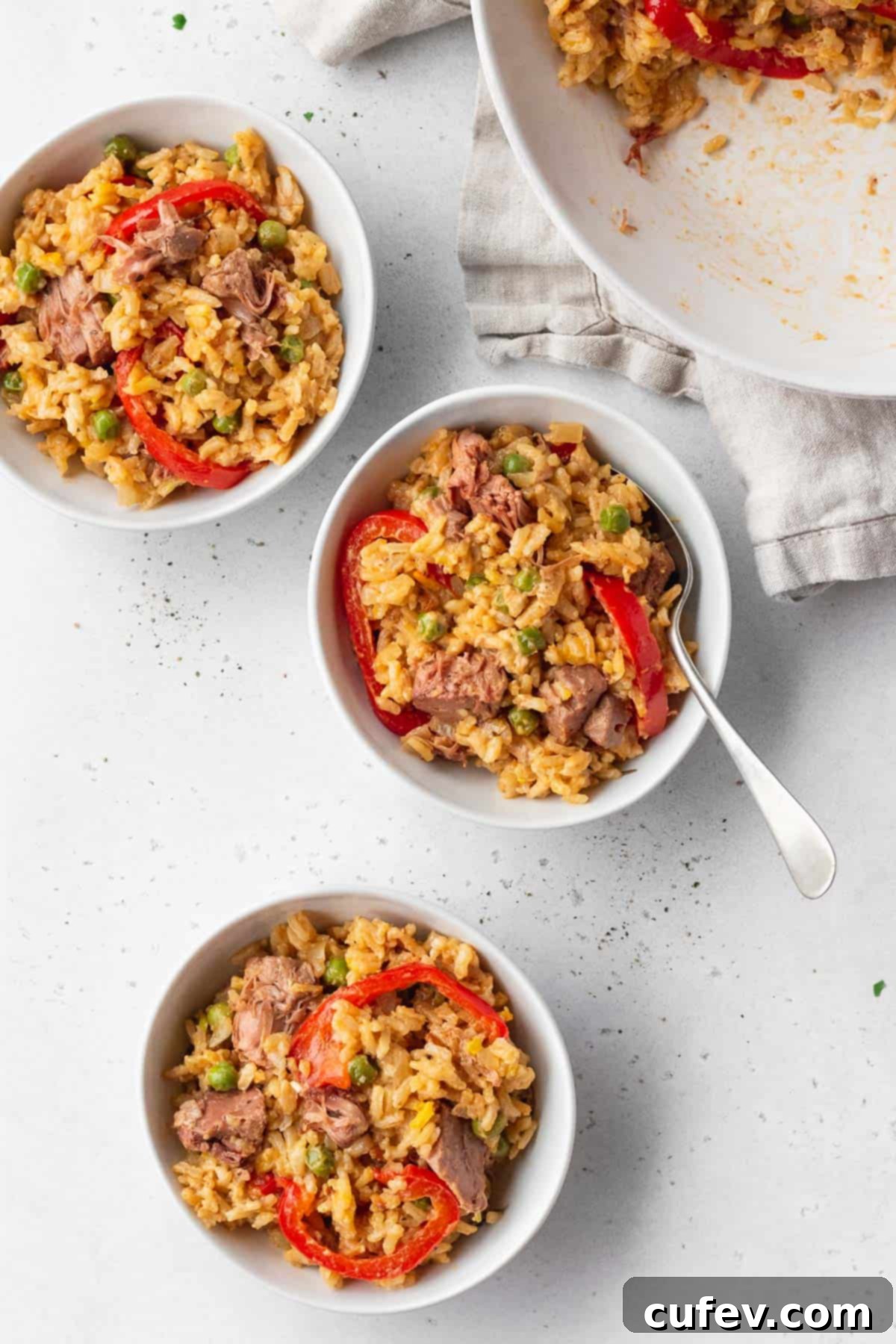
How to Make Arroz Valenciana Ahead of Time
Preparing this delicious Arroz Valenciana in advance is a fantastic way to streamline your meal prep or ease the stress of entertaining. This dish holds up beautifully, making it an excellent candidate for cooking ahead.
You can comfortably prepare the entire recipe 2 to 3 days before you plan to serve it. Once cooled, transfer the Arroz Valenciana to an airtight container and store it in the refrigerator. When you’re ready to enjoy, reheating is simple:
For best results, reheat individual portions in the microwave. Place the rice in a microwave-safe bowl and cover it loosely with a silicone lid or a piece of plastic wrap (vented) to help retain moisture and prevent the rice from drying out. Microwave in 1-minute increments, stirring gently after each minute. Continue until the dish is thoroughly heated through. Stirring ensures that the heat distributes evenly, preventing cold spots and promoting uniform warmth. You can also add a tablespoon or two of vegetable broth or coconut milk before reheating if the rice appears a little dry.
Storage and Freezing Directions
Ensuring your leftover Arroz Valenciana remains as delicious as when it was first made is simple with these storage and freezing tips. This flexibility makes it perfect for meal prepping!
Storing Leftovers in the Fridge
After your meal, allow any leftover Arroz Valenciana to cool down to room temperature within two hours of cooking. Then, simply transfer it to an airtight container. It will keep beautifully in the fridge for up to 3 days. When it’s time to reheat, use the microwave for convenience. Place your portion in a microwave-safe dish and make sure to cover it with a silicone lid, plastic wrap (vented), or even another plate on top. This crucial step traps steam, preventing the rice from becoming dry and ensuring it warms up moist and flavorful.
Storing Leftovers in the Freezer
For longer storage, Arroz Valenciana freezes exceptionally well. Once completely cooled, spoon leftovers into freezer-safe airtight containers or heavy-duty freezer bags. Ensure as much air as possible is removed from freezer bags to prevent freezer burn. It can be stored in the freezer for up to 3 months without significant loss of quality. When you’re ready for a quick and comforting meal, simply remove a portion from the freezer. You can microwave it directly from frozen, heating in short increments (2-3 minutes at a time) and stirring frequently until piping hot. For best texture, adding a splash of water or vegetable broth during reheating can help revive the rice.
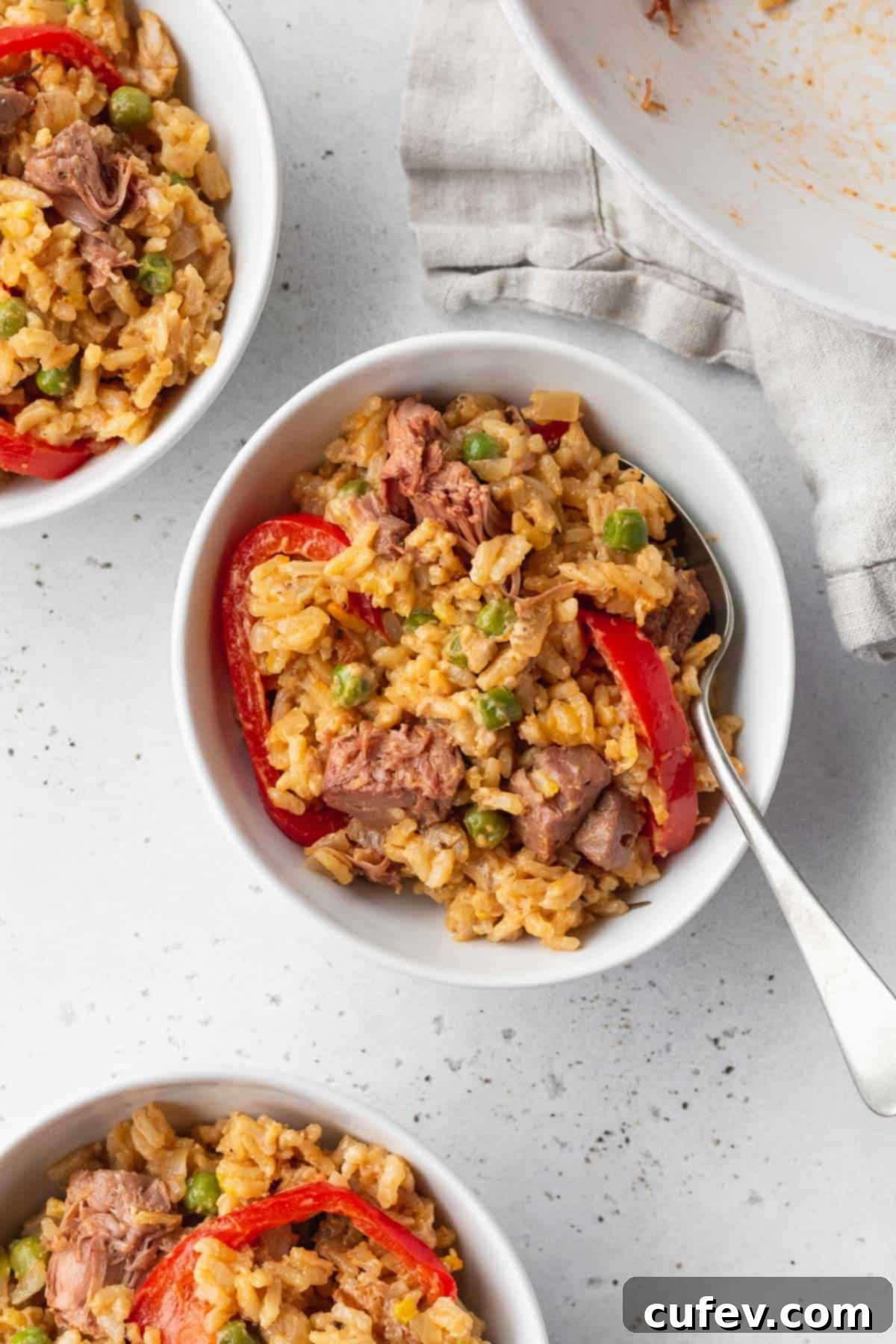
Frequently Asked Questions
While both paella and Arroz Valenciana are celebrated rice dishes that utilize saffron for its distinct flavor and color, there are several key differences that set them apart. Firstly, the rice selection differs significantly: Arroz Valenciana traditionally employs a unique blend of fragrant jasmine rice and sticky rice (malangkit), which contributes to its characteristic creamy yet separate grain texture. In contrast, Spanish paella typically uses specific varieties of short-grain Spanish rice, such as Bomba or Calasparra, known for their ability to absorb liquid without becoming mushy. Secondly, the cooking liquid varies: Paella is typically cooked in a rich seafood or chicken stock, whereas Arroz Valenciana famously combines stock with rich coconut milk, imparting a distinctively Filipino creaminess and flavor. Finally, the cooking method is distinct: Authentic paella is traditionally cooked in a wide, shallow pan (a paellera) over an open flame and is often finished in the oven, allowing for the formation of a prized crispy rice crust at the bottom (socarrat). Arroz a la Valenciana, on the other hand, is primarily cooked on the stovetop in a deeper pot, more akin to a stewed rice dish, without the emphasis on baking or forming a crust.
The culinary legacy of Spanish influence has led to many countries developing their own beloved versions of Arroz Valenciana. Beyond its prominent place in the Philippines, variations of this comforting rice dish can be found in a diverse array of nations. These include several South American countries such as Bolivia, Chile, Colombia, and Nicaragua, as well as Central American nations like El Salvador. Furthermore, it’s also a cherished dish in the Mariana Islands and even in Portugal, where it takes on local nuances. Each country adapts the core concept to its regional ingredients and flavor preferences, resulting in a rich tapestry of similar yet unique “Valencian-style” rice dishes.
For an authentic and truly delicious Arroz Valenciana, the optimal choice is a thoughtful combination of fragrant jasmine rice and malangkit, which is Filipino sticky rice (also known as glutinous rice or sweet rice). This blend is essential because jasmine rice provides a lovely aroma and a tender, separate grain texture, while malangkit rice contributes a subtle sweetness and the signature chewy, slightly sticky consistency that defines the dish. If jasmine rice isn’t available, you can substitute it with a good quality long-grain white rice. In situations where malangkit is hard to find, regular sticky rice or even sushi rice (a type of short-grain rice) can be used as an alternative, though you might not achieve the exact same nuanced sweetness or perfectly chewy texture. The key is the combination, as it creates a harmonious balance in the final dish.

Essential Tools Needed to Make This Recipe
To ensure a smooth and enjoyable cooking experience for your Vegan Arroz Valenciana, having the right kitchen tools at hand is beneficial:
- Heavy-Bottom Pot or Dutch Oven: Essential for even heat distribution, which is crucial for cooking rice properly and preventing sticking or burning.
- Wooden Spoon or Spatula: Ideal for stirring and scraping the bottom of the pot without scratching its surface.
- Chef’s Knife: For efficiently chopping onions and bell peppers.
- Cutting Board: A stable surface for all your chopping and dicing needs.
- Can Opener: For easily opening cans of jackfruit confit, coconut milk, and tomato paste.
Other Delectable Vegan Main Dishes
If you’ve enjoyed this Vegan Arroz Valenciana and are looking for more plant-based culinary inspiration, here are some other fantastic vegan main dishes to explore:
- Vegan Macaroni Gratin: A creamy, cheesy, and comforting casserole perfect for any occasion.
- Vegan Japanese Cream Stew: A rich and warming stew filled with vegetables and a delightful creamy broth.
- Vegan Katsu Curry: Crispy plant-based cutlets smothered in a savory Japanese curry sauce.
- Vegan Pot Pie: A classic comfort food, reimagined with a flaky crust and hearty vegetable filling.
- Vegan Mushroom Risotto: Creamy, earthy, and utterly satisfying, a true Italian-inspired delight.
- Vegan Thai Green Curry: A vibrant and aromatic curry packed with fresh flavors and textures.
- Spicy Yaki Udon (Vegan Massaman): Chewy udon noodles tossed in a rich and spicy Massaman-inspired sauce.
- Vegan Red Curry Mac & Cheese: A fusion dish bringing together the best of creamy mac and cheese with a kick of red curry.
- Easy Vegan Pasta Salad: A fresh, light, and customizable salad perfect for picnics or quick lunches.
Don’t forget to follow me on Instagram and Pinterest, and go subscribe to my YouTube channel for more delicious vegan recipes and cooking inspiration!
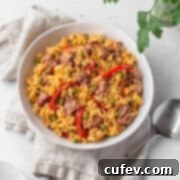
Vegan Arroz Valenciana
Ingredients
- 1 cup jasmine rice
- ½ cup sticky rice
- 2 cans Nature’s Charm jackfruit confit
- 1 tablespoon olive oil
- 1 medium onion finely chopped
- 3 cloves garlic minced
- ½ teaspoon sea salt
- ½ teaspoon black pepper
- pinch of saffron
- ½ teaspoon smoked paprika
- pinch of cayenne pepper
- 1 tablespoon tomato paste
- 1⅓ cup vegetable stock
- 1 can Chef’s Choice coconut milk
- 1 medium red bell pepper sliced
- ½ cup frozen peas
Instructions
- Rinse and drain the jasmine rice and sticky rice. Set it aside.
- Heat a large heavy-bottom pot over medium heat, and add 1 can of jackfruit confit including the oil, and 1 can of drained jackfruit confit. Cook while breaking the jackfruit into bite-size chunks until the edges become crispy. Take them out on a plate and set them aside.
- Wipe the pot clean and heat it again over medium-low heat and add the olive oil. Sautée the onions and garlic for 5 minutes while stirring frequently, or until the onions are translucent.
- Add the salt, black pepper, saffron, smoked paprika, cayenne pepper, and tomato paste. Stir until the spices and tomato paste have coated the onions.
- Pour in the vegetable stock and coconut milk and turn the heat up to medium heat. When the mixture reaches a boil, add the rice and stir. Once it reaches a boil, cover the pot and lower the heat to low. Let it simmer for 5 minutes.
- Open the lid, add the peas and bell peppers and stir. Put the lid on again and let it simmer for 15 minutes. Turn the heat off and let it sit for an additional 5 minutes with the lid on.
- Taste the rice for seasoning and add extra salt or black pepper if necessary. Add the crisped jackfruit and serve while hot.
Notes
Nutrition
SAVE THE RECIPE ON PINTEREST FOR LATER!
This post is proudly sponsored by Chef’s Choice and Nature’s Charm. All opinions expressed in this post are entirely my own and reflect my genuine experience with these products.
